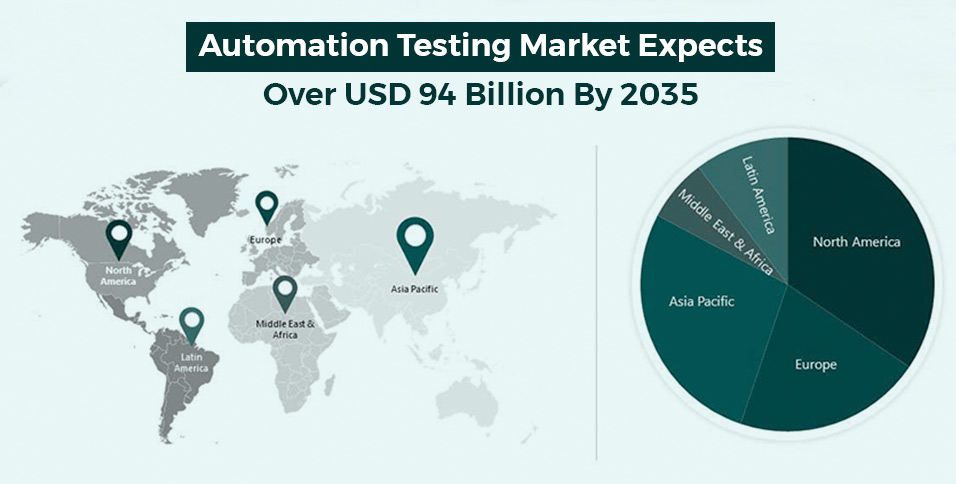Research Nester’s recent market research analysis on “Automation Testing Market: Global Demand Analysis & Opportunity Outlook 2035” delivers a detailed competitor’s analysis and a detailed overview of the global automation testing market in terms of market segmentation by component type, service, endpoint interface, end user, and by region.
Growing Implementation of Artificial Intelligence in Industrial Revolution to Drive Growth of the Global Automation Testing Market
The global automation testing market is estimated to grow majorly on account of the rising use of technology that uses artificial intelligence followed by higher use of AI in businesses.
In the near future industry 4.0 would be brought about in its full form by increasing the digital transformation of industries. This technological revolution involves integrating cloud computing, artificial intelligence, the internet of things, and other technologies into industrial settings and procedures.
In companies all around the world, there are now a record-breaking 2.7 million industrial robots at work, up 12% from the previous year, according to the new World Robotics 2020 Industrial Robots research published by the International Federation of Robotics. with a worldwide shipment of 373,000 units in 2019. Moreover, by 2021, AI was a standard tool in offices, according to 86% of CEOs. In addition, 80% of retail executives expect their businesses to embrace AI-powered intelligent automation by 2027.
Besides this, the market growth is also attributed to the rising adoption of smart autonomous vehicles in the world followed by growing demand for infotainment system in vehicle. These vehicles employ advance technology such as artificial intelligence. Automated testing is used to assess the security and safety of autonomous vehicles in practical situations. Global smart car shipments are expected to total about 76 million annually by 2024. Moreover, automated testing helps in the development of the software of the infotainment system in a smaller budget. The worldwide in-car infotainment market has grown as a result of the introduction of cloud computing and the widespread use of smartphones. Almost 82% of automobiles sold in 2019 have a dashboard touchscreen, up from about 53% in 2014. Many experts believe that this is the right time to invest in an Automation testing training program to enhance the expertise of the employees.
Some of the major growth factors and challenges that are associated with the growth of the global automation testing market are:
Growth Drivers:
- Surge in the Demand for Automotive Infotainment Systems
- Rising Use of AI in the Businesses
Challenges:
The initial investment in implementing automated testing into the business is expected to impede market growth. The initial automated infrastructure required a significant level of investment in terms of human capital, infrastructure, equipment, and other components. Additionally, test automation of buildings in the construction sector is more expensive than it already is, and in some instances, additional running, licensing, and facilitating costs are also incurred. Hence, implementing automation becomes costly for small enterprises.
On the other hand, it can be difficult to transition from manual to automated testing, and a lack of experienced automation testers are some of the major factors anticipated to hamper the growth of the global automation testing market. Owing to the lack of skilled automation testers, the frequency of delivery, customer satisfaction, and attention to minute details is compromised especially at the initial stage of development.
By end user, the global automation testing market is segmented into IT & telecommunication, BFSI, healthcare, retail, and transportation & logistics. The IT & telecommunication segment is to garner the highest revenue by the end of 2035 by growing at a significant CAGR over the forecast period. The increased usage of cutting-edge technologies, including AI, ML, and cloud in the IT and telecommunications industries is accountable for the segment’s rise. Artificial intelligence is used by businesses in the telecom sector for cybersecurity and customer support in over 52% and almost 48% of cases, respectively. The industry can increase customer experience and optimize operations related to customer care by integrating artificial intelligence.
Furthermore, telecom companies are collaborating technology offering businesses for implementing automation into the business. Xiaomi also chose Keysight’s automated field-to-lab device test platform solutions in April 2022. These solutions evaluate 5G technologies supporting smartphones and internet of things devices using channel simulation and artificial intelligence (AI) software.
By region, the North America automation testing market is to generate the highest revenue by the end of 2035. The market’s expansion can be largely ascribed to the increase in investments in cutting-edge technologies such as machine learning, artificial intelligence, and cloud computing. In 2019, the United States made USD 37 billion in the market for machine learning applications. Additionally, funding for artificial intelligence companies in the US has increased significantly in recent years, from around USD 300 million in 2011 to over USD 17 billion in 2019. Also, on the account of increasing use of test automation, market growth in the region is anticipated. Using Provar’s test automation for Salesforce, Canada Drives was able to reduce their human regression work by 95%, saving 38 hours for each deployment. Also, the business reduced its automation maintenance effort by more than 80%, which resulted in a monthly savings of 33 hours.This report also provides the existing competitive scenario of some of the key players of the global automation testing market which includes company profiling of IBM Corporation, Micro Focus International Plc, Capgemini SE, SmartBear Software, Tricentis, Parasoft, Cigniti Technologies Limited, Keysight Technologies Inc., Invensis Technologies Pvt. Ltd., and Sauce Labs Inc.
Also Read: What is Automation Testing in QA?
















